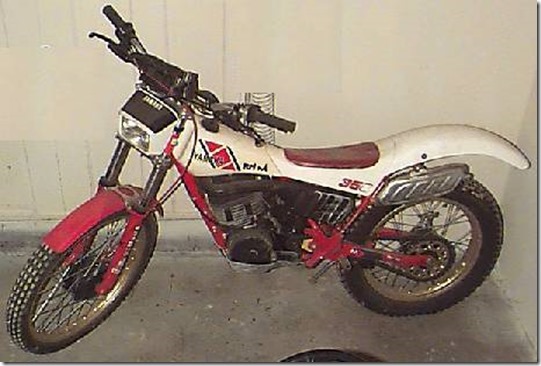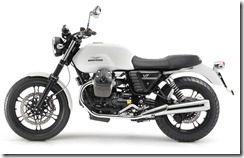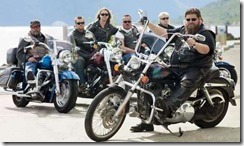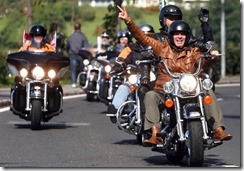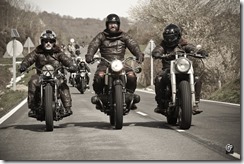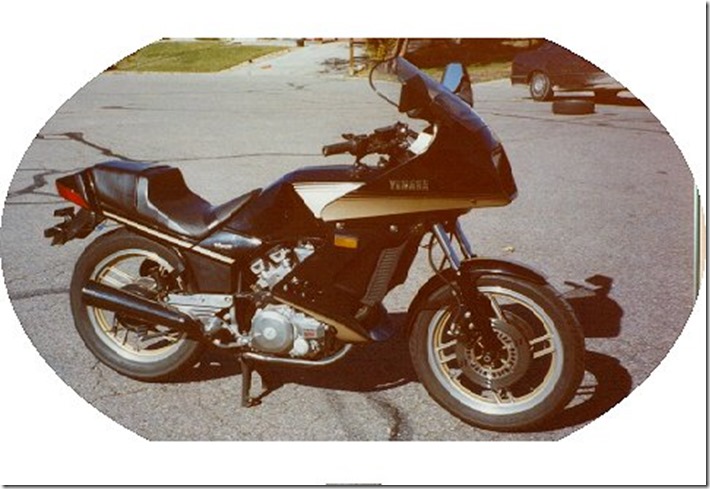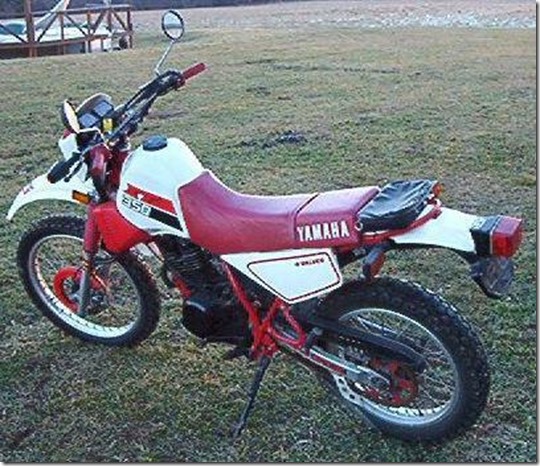There is a big difference between the columns I write for MMM or Rider’s Digest and the stuff I put on my blog. The main difference is proofreading. When I write for someone else’s publication, I try to round off the edges so that while I might intend to piss someone off I won’t do it accidentally (although some people misread anything written and you can’t help but wad up their panties with any sequence of words). For publication, I currently have about 20 articles in the que with another dozen almost finished but which will get a few more hours of rewriting before they are plopped on to the que. If my editors saw fit (and I’d love it if they did) and I died tomorrow, I could still be putting out “new” articles two years later. As H.L. Menken said, “I write for the same reason cows give milk.” When I write for myself on this blog, I don’t worry about that stuff as much as I do trying to get out a point before it’s lost in my wrinkled grey matter. I have nothing in the que for this blog, other than the automatically logged stuff previously published that will end up here about a year or two after it’s in print. I give my publishers first publication rights, but I keep the right to self-publish here and on Wordpress.
While I would never encourage anyone to take me seriously anywhere you read my stuff, getting overwrought about an opinion you read here is an unnecessary strain on both your heart and credibility. I’ve said, for years, that I only believe about 1% of what I read, 10% of what I hear, and 50% of what I say. Your mileage may vary.
A couple of readers whose opinions and thoughts I respect considerably were really disappointed with my comments about Moto Guzzi’s M-something-or-other in a recent rant, Where We’re Going. To be clear, I don’t take much of anything from Europe, machine-wise, seriously. If Finland made a motorcycle, I’d be interested in looking at it, but I wouldn’t trust a bike from Greece, Spain, Italy, Germany, or England any further than I could toss it. Been there, done that, thirty and fifty years ago and I’m still holding a grudge. It’s who I am.
More importantly, I wouldn’t invest more than 50% of what I am absolutely certain I could get out of a Euro-trash bike because I’d sell it as fast as I could find a buyer. That’s also who I am and you will have nothing, argument-wise, to beat that one back. It’s, honestly, not the machines with which I have a grudge, it’s the lousy European mismanagement and their complete inability to commit to building a dealer network. Now that VW owns Ducati, that brand is even further down my shitlist of undesirable machines than before: Germany times Italy equals the worst of everything humans do. If Saudi Arabia made a motorcycle, I wouldn’t expect it to be less interesting or more poorly supported. If you have a problem with that, talk amongst yourselves because I’m out of it. I will not live long enough to get over this grudge and wouldn’t want to. I plan to stay retired and don’t expect any new money to help with that.
However, the point of Where We’re Going would have been in the other 75% of that essay that speculated on the possibility that the frivolousness of American motorcycling may be pointing to the likelihood that motorcycles are on a short public road longevity leash. It should always be pretty obvious that the majority of the content in any sort of article is the actual point, but maybe not.
Thanks to the curse of my personality and past occupation (test and reliability engineering), I actually have a pretty good record of predicting bad shit. I’m retired because I accurately predicted four painful economic downturns and placed a strong bet against our bubble economy on three of them. (I only missed the 4th because my shithole Misfortune 500 job had beaten me down so far that I didn’t care if the world and my own bank account sank into the swamp. Hell, by the time I quit that POS job, I couldn’t even read headlines let alone place a sell order on my investments.) To be clear, I have no ability to spot the early leading edge of “irrational exuberance.” I got into Microsoft a little late and got out way early, likewise Marvel Corp, Disney, Genome, Texas Instruments, and a raft of alternative energy investments and commodities. Because I always expect the worst, I almost never get burned but I rarely strike gold. I do get a lot of silver, copper, tin, steel, and well-manufactured products, though. All of my past stockbrokers are either dead or still working for a living and doing it out of necessity. I ignored 99% of their “better jump on this stock” advice and all of their “hold till it gets better” advice and I’m retired and they are not. Most of them are a good bit older than me, too. A couple of them died underwater on investments and real estate. This is my analysis resume: I’m good at predicting when stuff will turn to shit. Four different industries paid me well to tell them when their products would belly-up over 30 years in industry. In one particularly evil industry, part of my job was to predict when our asshole execs should divest themselves of their stock options because the flaws in our product designs would sink the company and its stock value. You can read more about that in one of my other blogs, if you care.
So, with that as a background, try not to focus on how much I distrust Moto Guzzi’s dealer network, hipster styles, or pirate outfits. It was not my point. The original essay was inspired by the fact that motorcycle sales are down and sinking and dealerships are experiencing hard times even in a fairly up economy. Fishing for reenactment business seems very much like the endgame, like those small towns who have nothing but 2nd hand stores left. I've had a couple of private conversations with people in the gear and accessory industry who think they may not survive another year like this. You might be surprised who is thinking these thoughts. These are businesses that have been around a while.
Couple that with my own experience with a couple dozen "new riders," who got into motorcycling for that brief moment when it was hip to be a retro-biker (a trend that peaked about a year ago) and who have already moved on, and away from motorcycles, after a few months experience. That "current fad" is fading into the past quickly. So, what's wrong with it is not that I give a damn about the fad, am offended by the style, or have some sort of moral/engineering objection to the styles and fashions of motorcycles or motorcyclists. It's that it appears to be a quickly passing fad with no serious follow-up consumers.
Harley and Polaris have been counting on the dress-up market for a couple of decades. The people they sell to are old and are on the edge of moving on from their three-wheel wheelchairs to the real thing. Honda hoped the NC700/500 models might attract some practical riders, something resembling long term business, but those bikes are now getting blown out with major discounts. From V-Stroms of both sizes and all models, 250s and 300 sport bikes and dual purpose bikes, big and small sportbikes, cruisers, there doesn't seem to be a model group that is selling. All of that is true for the support business, too. At least from the folks I've talked to, it sounds like gear, accessories, tools, and aftermarket parts sales are down with a pretty poor long term outlook. I don't pay for insider industry information, like PowerSports, so I can't claim access to industry sales data. I’m old and at the tailend of my riding life, so I don’t care much, either. It's pretty widely known that Suzuki planned on closing about 20% of its dealerships in 2013, but more like 30% actually went away. Harley's dealership numbers are below what they were in 2000. Their sales are unreliably hyped by inventory shuffling and money sleight-of-hand games. Harley recently fired the marketing people who were responsible for attracting “under 35 year old consumers” to the brand. I see no evidence that they made the slightest dent into that consumer group. Triumph and Ducati dealers are closing or consolidating.
Here in Red Wing, our local Big Three dealer is dumping 2014 and 2015 bikes and, from what my neighbor (a friend of the owner) said, the dealer might be planning to replace the inventory with the dead minimum motorcycle buy for 2016 and dropping one or two brands. He has two other dealerships and, again from rumor, will be eliminating motorcycles from both of them in a year or so without some sort of change in the business. Boats, jet skis, ATVs, campers, farm equipment, and even snowmobiles are moving. Motorcycle sales are down and sinking. In the Cities, dealers vanish regularly and are either absorbed by other dealers or just disappear.
One well-considered reader/friend asked, “So if the current hipster fads of making old jap bikes into bobbers/cafe/brat style what-evers helps push the manufacturers into making what the kids want to see, what’s wrong with it?” “Wrong” is the wrong word. My feeling is that the existence of this sort of “market” is exactly what’s “wrong” with Midwestern cities lined with 2nd hand stores and no actual businesses. It’s a logical response to a dying industry. Hipsters spend a few weeks wrapping tape around a rusty exhaust pipe, buying flat bars at garage sales and dealer bankruptcy clearances, hacking fenders short, and they ride for a few weeks until they get scared by a near-miss and quit. The gangbangers are either pissing off the general public with their hooligan antics or scaring the shit out of them with their mobster tactics and they are old, fat, unhealthy, and steal their bikes and parts rather than buy them. The gangbanger wannabes are old and incompetent and contribute mostly to morbidity/mortality statistics. The 1% of riders who are on the road regularly, regardless of weather or trendiness, are (I think) a lot more common in other countries. Throughout the swings of the economy and trends, these are the riders are who preserve motorcycle rights/privileges and who the industry counts on to provide steady revenue and new product markets. If the whole number is shrinking, that 1% will eventually become too small to support anything other than hobby business. Again, look at small town economic disintegration to see a recent example of how that all works. 2nd hand stores are hobbies, not businesses.
Sadly, when Kevin Cameron said about my column and blog, “Nobody else does this emperor's clothes kind of thing!” This is the kind of thing he was talking about. There is no motorcycle magazine on the planet that would publish an “end of times” article. Advertisers would panic. I, on the other hand, don’t have any skin in this game. I could, also, be really wrong. I hope I am. What’s happening here is definitely different than much of the rest of the world.
When and where I first started riding in the 60s, it was much worse than now. In Kansas, most people hated motorcycles and motorcyclists and I am not exaggerating when I say it was pretty common to have someone try to knock you off of the road. Truck, cars, and even cops would intentionally crowd me close enough to make contact. So, I just started riding in the ditches. Kansas, Oklahoma, and Texas are still places I wouldn't consider touring on the WR250 for that reason. I'd want at least a 650 for the power to keep some space between me and hostile cagers. I have always blamed the biker gangsters for this attitude. The gangbangers were pretty common sight on Harleys, BSAs, Nortons, and Triumphs making noise and being assholes back then. Americans are, I think, more timid, conservative, and afraid of most everything than most people, in my experience. We're not warlike because we're brave or give a shit about justice or freedom. We want to blow the shit out of everything because we're afraid of everything from different races, religions, economic systems, languages, to architecture. On motorcycles, too many riders are terrified of the risk and want someone else to “fix it” for them. All that “start seeing motorcycles” and asking for harsher punishment for “right of way” violations and insane expansions of motorcycle right of way claims are part of that.
A lot of the problem with motorcycling in the US is because we're afraid of risk, as a culture. That might be why our actual inventors, scientists, athletes, and entrepreneurs standout so dramatically in contrast. However, that’s a whole different rant.
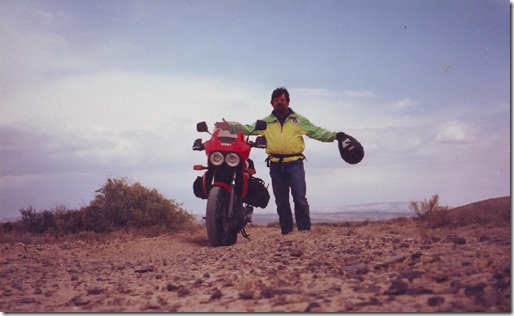 Learn (a lot) more about this bike
Learn (a lot) more about this bike  I put ninety-some thousand miles on that bike in six years. Most of those miles came in the first two years. I did two extended trips on the TDM. Obviously, my days of using motorcycles as primary transportation were coming to an end. After moving to Minnesota, the "adventure touring" aspect of the TDM's design became less a part of my motorcycling activity. Between becoming a grandfather and the long Minnesota winters, most of my motorcycling was limited to commuting to work and short weekend morning trips into the country-side.
I put ninety-some thousand miles on that bike in six years. Most of those miles came in the first two years. I did two extended trips on the TDM. Obviously, my days of using motorcycles as primary transportation were coming to an end. After moving to Minnesota, the "adventure touring" aspect of the TDM's design became less a part of my motorcycling activity. Between becoming a grandfather and the long Minnesota winters, most of my motorcycling was limited to commuting to work and short weekend morning trips into the country-side. 